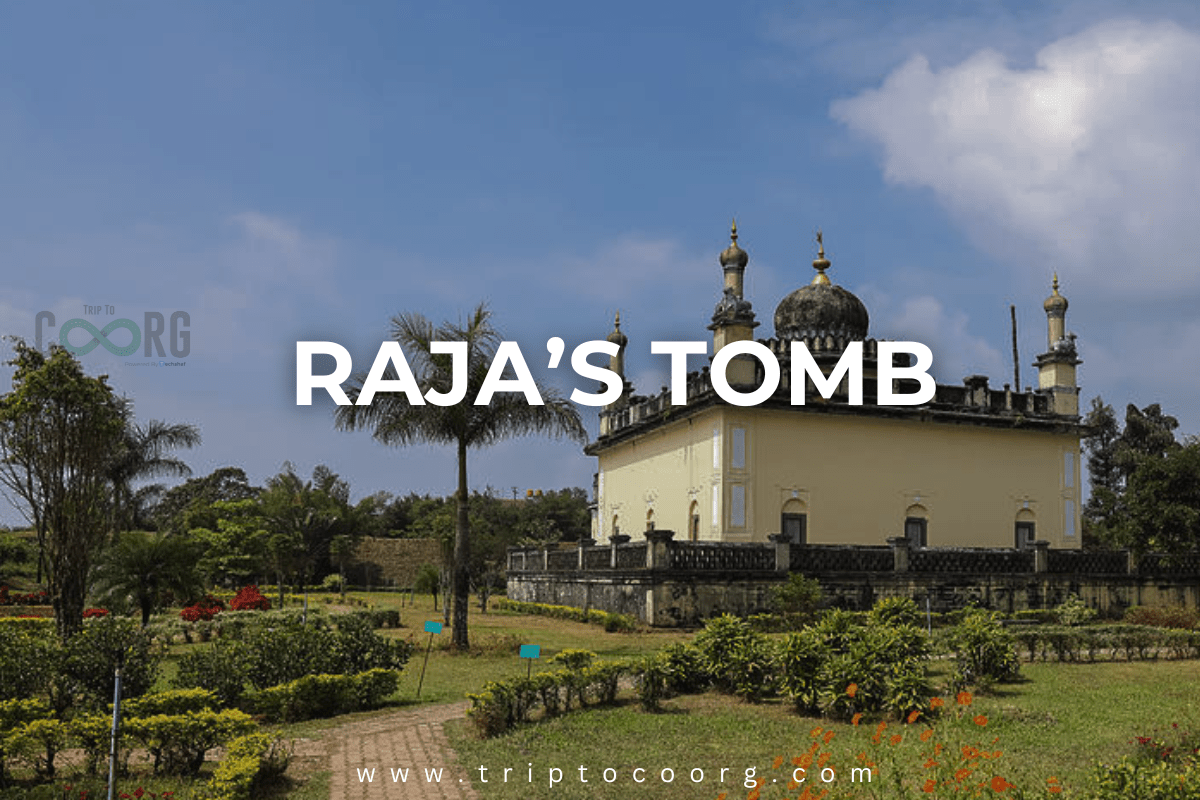Introduction:
Raja’s Tomb, also known as Gaddige or Gaddige Tombs, is a historical site located in the Coorg (Kodagu) district of Karnataka, India. Raja’s Tomb stands as a significant historical monument and a testament to the rich heritage of the region. Located in the heart of Madikeri, district’s main town, this site offers a glimpse into the regal past of Coorg and the architectural prowess of bygone eras. This mausoleum complex is notable for its architectural style and historical significance, providing a glimpse into the rich cultural heritage of the region. The tombs are located approximately 6 kilometres from Madikeri, making them easily accessible for visitors exploring the area. The site is set amidst a picturesque landscape, adding to its historical and aesthetic appeal. Raja’s Tomb is a well-preserved example of the local royal architecture and serves as a testament to the history of the Kodagu rulers. The tomb is a striking example of Islamic architecture and stands out amidst the lush greenery of Coorg, reflecting the region’s unique blend of cultural influences.The monument is located at a site with an elevated view of the surrounding landscape, providing a serene and scenic backdrop. The tomb’s architecture and historical significance make it a popular destination for visitors interested in history and heritage.
Raja’s Tomb is renowned for its distinctive architectural style, which combines elements of Islamic design with local influences. The structure features a domed roof, intricate stone carvings, and elegant arches. The use of granite and the symmetry of the design are reminiscent of Mughal architecture, highlighting the cross-cultural influences in the region. The tomb is dedicated to Chikka Veerarajendra and Linga Rajendra, who were significant figures in Kodava history. Chikka Veerarajendra, the last ruler of the Kodava dynasty, was known for his efforts to maintain the autonomy of Kodagu during a period of political turmoil. His son, Lingarajendra, succeeded him, continuing the family’s legacy. The tomb commemorates their contributions to the region’s history. Raja’s Tomb is famous for its architectural beauty, historical importance, and cultural heritage.
Raja’s Tomb is dedicated to two notable figures in the history of Coorg: Chikka Veerarajendra and his son, Linga Rajendra. Chikka Veerarajendra, who reigned during the 19th century, was the last sovereign ruler of Kodagu before the region came under British control. Known for his resistance against British encroachment and his efforts to maintain the autonomy of Kodagu, Chikka Veerarajendra is a celebrated figure in Kodava history. Lingarajendra, his successor, continued his father’s legacy. Although his reign was marked by some controversies, including conflicts with the British, he is remembered as an important leader in the region’s history. The tomb serves as a memorial to their contributions and the historical significance of their rule.
Distance : From Bangalore: Raja’s Tomb is about 260 kilometres from Bangalore, taking around 6-7 hours by road. From Mangalore: It is approximately 130 kilometres from Mangalore, with a driving time of about 3-4 hours. From Mysore to Raja’s Tomb in Madikeri, Coorg is approximately 120 kilometres (75 miles). The journey typically takes around 3 to 4 hours.
Visiting Raja’s Tomb:
Visitor Experience: The site offers a tranquil environment, making it an excellent spot for visitors interested in history, architecture, and culture. The well-preserved structure and its scenic surroundings provide a unique opportunity to explore the heritage of Coorg.
Tourism Information: Raja’s Tomb is managed by local authorities, and guided tours may be available to provide in-depth information about the monument’s history and significance. The site is generally open to visitors during daylight hours, and it is advisable to check with local sources for current visiting hours and any special events.
Accessibility: Raja’s Tomb is easily accessible from Madikeri, with well-connected roads leading to the site. Public transportation options, including buses and taxis, are available, but hiring a private vehicle or taxi may offer more convenience.
The ideal time to visit Raja’s Tomb is between October and March when the weather is pleasant and conducive to outdoor activities. The cooler months provide a comfortable environment for exploring the site and enjoying the surrounding scenery. Comfortable and modest clothing is recommended when visiting Raja’s Tomb. Since the site involves walking and exploration, comfortable footwear is advisable. Additionally, wearing light clothing and carrying a hat or sunscreen can enhance your comfort during the visit. When visiting Raja’s Tomb, it is important to respect the historical and cultural significance of the site. Maintain a respectful demeanour and avoid disturbing the peaceful environment. Photography may be allowed in designated areas, but it is always a good idea to check with local staff or guides for any restrictions.
Conclusion: Raja’s Tomb is a remarkable historical site that offers a window into the regal past of Coorg. Its striking architecture, historical significance, and serene location make it a noteworthy destination for those interested in exploring the cultural heritage of Karnataka. Whether you are a history enthusiast, a cultural explorer, or simply someone looking to appreciate the beauty of Coorg, Raja’s Tomb provides an enriching and memorable experience amidst the lush landscapes of this enchanting region.


0 Comment